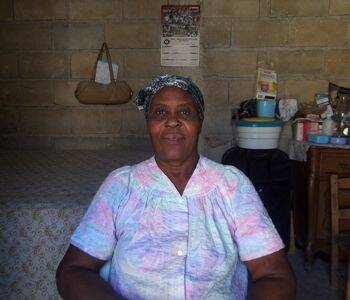It took almost two years, but Haitian earthquake survivor Sonya Mallebranche has a place she can call home again. It's only three rooms, making it less than perfect, Mallebranche admits, especially for four adults and three toddler grandchildren. But Mallebranche, 51, finds it far better than living in a tattered tent in the fetid, dusty camp known as Petite Place Cazeau alongside hundreds of others displaced by the powerful Jan. 12, 2010, earthquake that leveled much of the region around Port-au-Prince.
"I'm so much more comfortable. Now I can sleep peacefully. Now I have my family with me," Mallebranche said Jan. 5 via cell phone from her new home. "I am really happy to have that house," she said through a translator.
Mallebranche's family was among 460 families that have moved from the camp into long-term housing since November under a pilot program initiated by Catholic Relief Services, the U.S. bishops' overseas relief and development agency.
Called Ann Ale Lakay, Creole for Let's Go Home, the program is designed to address a variety of needs in addition to long-term housing by preparing camp dwellers frustrated by months of living in squalid conditions for a return to some sense of normalcy. The program incorporates two professional psychologists and 12 social workers to guide earthquake survivors in resolving conflict, managing money and overcoming the sense of loss that lingers two years after disaster disrupted their lives.
"We realized there was a lot of fear about moving out of the camps, about restarting their lives after the earthquake," explained Luke King, CRS country director in Haiti. "People were concerned about how to go about returning to a normal life."
Samuel Petit-Homme, deputy resettlement manager for CRS, helps administer the program, which he said takes about six weeks from introduction to moving day. Before camp residents are enrolled, social workers and psychologists work with camp and local political leaders to explain how it works and what it's meant to accomplish, he said.
As families complete the program, they are offered a $500 voucher to assist with their relocation. They are urged to approach a property owner to negotiate a yearlong rental agreement. King said some heads of families have proven to be strong negotiators, coming to terms on an agreement that costs less than the $500 being offered. Families can then pocket the difference while CRS pays the rent directly to property owners.
Families also get health insurance coverage for six months through the program as they get settled, said Niek de Goeij, head of programming central for CRS in Haiti. The program stresses the importance of budgeting for that expense -- about $30 for six months of family coverage -- so that when a health care need arises, families are not faced with the choice of bypassing a visit to a doctor or to sell a possession to cover care.
De Goeij explained that the resettlement program was a natural follow-up to the agency's effort that saw about 10,500 transitional shelters built at several locations around the quake zone. While that endeavor resulted in more than 50,000 Haitians being relocated from camps, agency officials realized people needed additional assistance to re-establish their lives, he said.
"It's an emotional experience to see the people move out," he said. "People cheer when they move out of the camps because they're getting into a regular house.
"People doubt whether Haitians are motivated to move out. To me it's an eye-opener to see that when people have a genuine opportunity to exit the camps and (move) into their neighborhood, they jump at it," he said.
The resettlement program has put a small dent in the camp population in and around Port-au-Prince. Aid agencies and the Haitian government estimate that about 500,000 people -- one third of the 1.5 million left homeless by the quake -- remain in the camps. But King said he is seeing more urgent efforts by various agencies working with the government to provide permanent housing.
"The government has gotten very involved in this return process as well," he said. "There's a lot of momentum at this time to help people return home."
Mallebranche said she now lives in more peaceful surroundings, giving her plenty of time to play with her grandsons, a 15-month-old and twin 3-year-olds. The daily headaches she attributed to the excessive heat in the camp have disappeared. And the putrid smell of the camp that she said forced her to leave her tent during daylight hours is gone.
"I'm feeling really good," she said.








